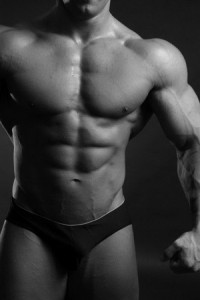 The end goal for most people in the gym is to translate the effort of lifting literally tons of iron into a healthy and attractive physique. However, many men are dissatisfied with the results of their struggles, even though an impressive amount of muscle may have developed.
The end goal for most people in the gym is to translate the effort of lifting literally tons of iron into a healthy and attractive physique. However, many men are dissatisfied with the results of their struggles, even though an impressive amount of muscle may have developed.
Muscularity, in the eyes of a bodybuilder, is meaningless if it is hidden beneath a blanket of fat, blurring the definition between muscle groups and often giving the appearance of nothing more than generalized obesity. It is the hardened, if not chiseled, look of a mythical hero that is typically sought, but rarely obtained.
Bodybuilders often turn to aerobic training in their attempts to shed the unwanted adipose. Unfortunately, they often choose an inappropriate aerobic routine that cannibalizes their hard-earned muscle and may even cause overtraining or injury.1 Aerobic training can be used successfully to reduce body fat, without sacrificing strength or muscularity. To do so, however, requires looking objectively at the underlying problem and then a determining the proper solution.
The Myth of Crosstraining
It would be a meaningless gesture to begin a fat loss program unless attention was focused upon the diet first.2 Without dwelling on this point, other than to raise it to the level of awareness, no aerobic program for fat loss should be attempted without first addressing calorie control.
Bodybuilders need to approach aerobics as bodybuilders. Despite being athletic individuals, they are not athletes in the sense that their sport is dependent upon complex, explosive movements or everlasting endurance. Many athletes attempt to be bodybuilders without giving up on being athletes, buying into the myth of “crosstraining.” Crosstraining is an excellent way to develop overall fitness and athletic skills, but it does not allow one to truly excel in any single specific sport. Instead, crosstraining is a popular pursuit, seeking to provide balance and variety to the general public, which is more interested in recreational fitness and the social interaction of sports.
A bodybuilder needs to approach aerobic conditioning as a tool, increasing low-intensity activity to maintain the metabolic rate, burning more calories within a given period of time, without sacrificing muscle or energy, or causing injury.
There are few studies looking at the impact of aerobic training on muscle gains. The definitive study on the compatibility of strength training and endurance training was reported in 1995 by Kraemer et al.3 Healthy, adult men were divided into groups that included those who performed only endurance training, those who performed only strength training and those who combined strength and endurance training. This study found that though the combined group (strength and endurance trained) made progress in both endurance and strength measurements, their progress was not as great as in those who focused solely upon either strength or endurance training. In other words, men who only strength trained were stronger and made better progress in the gym than those who combined strength and endurance training and those who only endurance trained were better runners than those who combined strength and endurance training.
Applying these results to the goals of a bodybuilder would suggest that combined endurance and strength training would at least slow any gains to be made in the gym. However, for those who are only lifting for generalized fitness, this and other studies have shown combined training can provide moderate benefits in both aerobic conditioning and strength.3,4
Guidelines and Choices
There are further issues that a bodybuilder must consider when choosing an aerobic program. Briefly, these include time, equipment, injury and specificity. Time is an obvious barrier. It can be difficult to schedule workouts, let alone adding 20-60 minutes for “cardio.” The ideal aerobic program should be as brief as possible, so as not to interfere with the demands of real life or the gym. Generalized recommendations for cardiovascular health suggest three 20-40 minute sessions of light to moderate activity per week. Fortunately, this would not be an excessive amount of activity for the bodybuilder’s purposes, and can serve as a fair guideline.
Most commercial gyms have a variety of equipment upon which one may comfortably watch television, enjoy a beverage and chat with a neighbor. Frankly, few of the machines used in gyms are truly employed for fat loss or cardiovascular fitness. A standard treadmill is as effective as any of the more complex aerobic equipment. There are some that are more challenging, such as the revolving staircase, but many that might have been designed with leisure and comfort in mind rather than effectiveness. If weather permits, outdoor walking is even more effective than the use of the treadmill.
Selecting a route with hills and inclines can provide a serious aerobic workout. For the competitive bodybuilder, sports and aerobic classes should be avoided.
In part, the recommendation against sports and aerobic classes involves the high risk of injury.5 It is seemingly inane to worry about walking on and off a step after squatting 315 for reps, but more injuries occur in aerobic classes than anywhere else in the gym. Most aerobic classes are designed for cardiovascular conditioning or weight loss (including muscle loss) and involve quick movements that require practice and grace. Movements like knee-ups, grapevine and weighted good mornings at a pace of 60 per minute may not be overly risky to the 140-pound mother of two, but to a 210-pound bodybuilder, they can cause serious joint or connective tissue injury.
Many of the machines can also cause joint stress, such as the elliptical trainers or rowing machines. These machines have fixed pedals or handles and if one is not properly aligned, inflammation or injury can occur. Many bodybuilders cannot use the fixed pedals properly, due to the muscle mass in their thighs, causing stress at the hips, knees and ankles. Even the use of spin bikes or other cycles may be harmful. Cycling has been associated with inflammation of the soles of the feet, carpal tunnel syndrome and even nerve damage in the groin.6,7
Most people choose activities that rely exclusively on leg movements for aerobic training, such as walking, jogging or biking. These choices make the impact of the aerobic training specific to one muscle group, which can be quite disadvantageous. Placing constant demands upon the legs (quads, hams and glutes) can slow, or even stop, any gains that might be made in these muscle groups as they will not have sufficient rest to recover from weight training or any opportunity to achieve a period of hypertrophy.8,9 Using this example, aerobic training should not be performed on leg day, as it would deplete glycogen stores and increase inflammation prior to the workout.10,11
Recovery is a major point against strenuous or prolonged aerobic training. Endurance athletes are under high levels of oxidative stress,12 they deplete the glycogen stores of the exercised muscles13 and may also suffer from dehydration and overheating.8,14,15 These are all extremely negative factors, which bodybuilders should avoid.
What’s a Bodybuilder to Do?
An ideal aerobic program for a bodybuilder should first take into consideration his usual lifestyle. If his occupation involves a great deal of activity, such as manual labor, then there is little need for more activity and greater benefit would be gained by enforcing a stricter diet. If his occupation is fairly sedentary, such as having a desk job or driving, then using the aerobic program to increase the amount of activity is a sensible approach. Regardless of the case, for the purposes of bodybuilding, aerobic training should be used only to increase the amount of low- to moderate-intensity activity for the purpose of increasing the number of calories burned.
The best choice for any one person is the choice that he will follow consistently. The simplest approach is to choose an outdoor route that has hills and flat stretches, alternately walking or jogging as the terrain and conditioning allows. Many people speak of a target heart rate, but since few people actually measure their heart rate while exercising, others recommend maintaining a pace that’s low enough to allow you to talk in short sentences, but not so leisurely as to allow a long dissertation on the hidden meanings of the Canterbury Tales.
Ideally, the aerobic training would take place first thing in the morning, after fasting (thus, before breakfast). Plenty of water should be consumed before and while walking/jogging/etc.13,16 Caffeine, taken 30-60 minutes prior to the exercise will improve fat burning,17 but that would require getting up an hour earlier, taking a caffeine tablet or brewing coffee, and then exercising. Many people also have difficulty tolerating caffeine on an empty stomach, so the use of caffeine may or may not be of some benefit.
Again, these comments do not specifically apply to recreational or novice lifters, as they may see great gains due to neuromuscular adaptation (basically improved coordination). Bodybuilders on steroids will be able tolerate a much higher level of aerobic training, as most anabolics provide protection from muscle loss either by decreasing muscle breakdown, increasing protein uptake into the muscle, or both.18 Due to their greater mass and strength, steroid-using bodybuilders may be at higher risk for injury during aerobic activity. Low doses of certain anabolics, including the popular pre-contest drug Winstrol, are rumored to be used by professional track athletes and cyclists to avoid overtraining and prevent muscle loss.
In closing, many bodybuilders choose to include aerobic exercise in their training to aid in fat loss, but many sacrifice their hard earned muscle and prevent future gains due to the nature and amount of cardio chosen. Bodybuilders should not engage in more than three 20-40 minute sessions of aerobic training per week, and they should only use aerobic training to support the fat loss efforts of a strict diet.
Attention needs to be paid to the style of training used for aerobics, as many of the machines, classes and activities may cause injury or impair later strength training. Aerobics will provide best fat loss results if performed upon rising, before eating, while in the fasted state. Drink at least one liter of water during the aerobics; some people may choose to use 100-200 milligrams of caffeine to increase fat burning. Sports beverages should not be used in place of water as many of them contain an excessive amount of carbohydrates. It’s best to include variety in the aerobic training, altering the course, speed and inclines of the routes or activities. While some experts recommend high- intensity interval training and others a more constant low- to moderate-intensity style, consistency is the key factor that will determine success.
source:musculardevelopment.com
